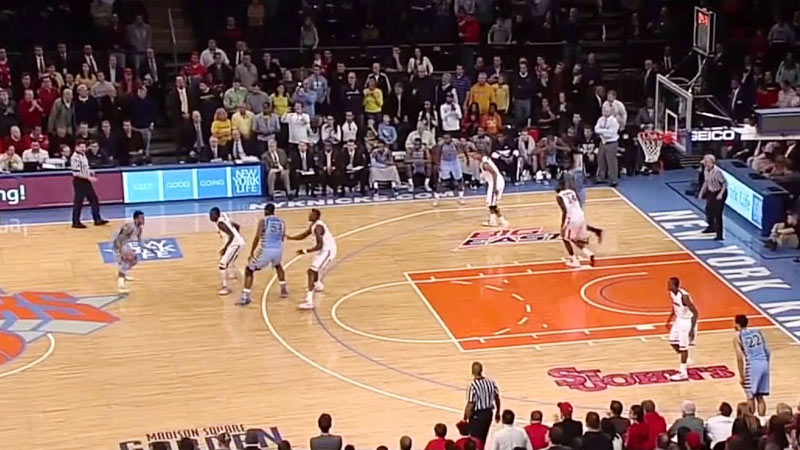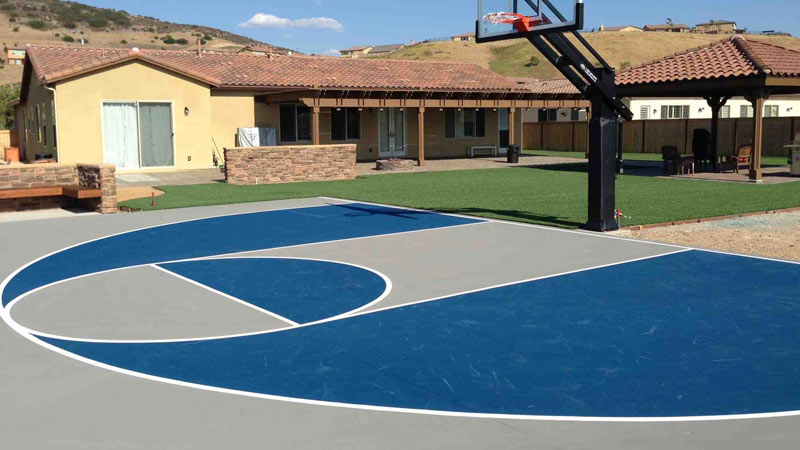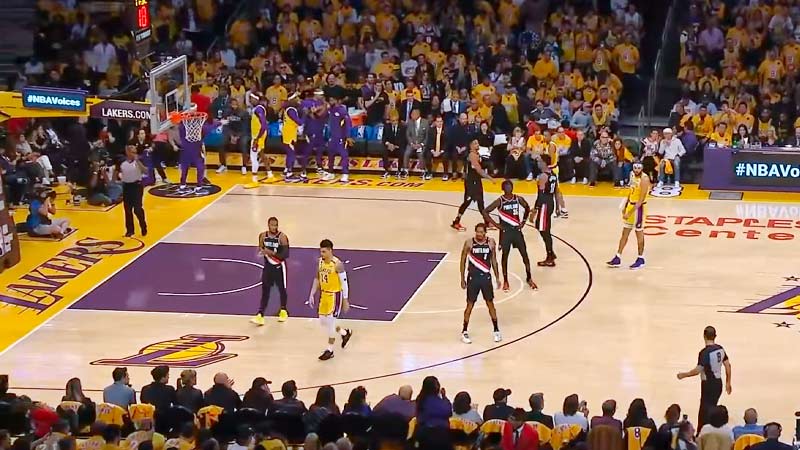We are here with another detailed topic for our daily article and today it is Court Lines in Basketball.
The court is the surface area where basketball takes place. NBA basketball courts are 94 by 50 feet (28.7 by 15.2 meters) in size. But what are the court lines?
To your surprise, court lines can often determine the fate of a basketball play. Lines ensure a fair play of basketball and also facilitate powerful basketball rules and scoring.
Thus, if you don’t want to solely rely on the commentator and be on your own, this guide is for you. Today, we are going to have an in-depth discussion on basketball court lines.
A Brief On Basketball Court
A basketball court is a symmetrical area; one half of the court matches exactly the other half of the court. Each side has a basket with 3.048 meter high rims on their half and in total, it is rectangular in shape.
While other leagues including FIBA and WNBA follow the NBA court dimension. FIBA has a comparatively smaller court in size; measuring 91.9 by 49.2 feet (28 by 15 meters).
Basketball is an interesting sport with a rich history. Dr. James Naismith, the inventor of basketball, once used running tracks for the basketball court.
Even though he clarified that basketball can be played on any kind of surface. Years of modification have brought the current version of the basketball court. We now mostly play on polished wood, usually maple.
What Are Court Lines in Basketball?
In a basketball court, there are four lines and marks. Each of them has a purpose to serve in the field. Despite setting up rules and regulations, they contribute more while making a score, foul, or defense strategy.
Let’s talk about it.
Baseline
Also known as the end line, the baseline is the boundary of the basketball court. You will find it behind the backboard; parallel to the length of the court at each end.
The baseline extends from side to side; reaching the area behind the basket. Each baseline is four feet behind the basket and 50 feet in width. Two baselines are 94 feet apart in a regular NBA court.
It is mandatory that the players have to remain inside the boundary during the game. Once he is beyond the bars, he is out of bounds. However, except when players attempt to inbound or perform other specific play, they can get beyond the boundary line.
Sideline

Source: fastmodelsports.com
In a basketball, the sideline runs parallel to the width of the court, from baseline to baseline. They are 94 feet long (equal to the length of the court) in the NBA and are best known for being the outer boundaries across the length of the court.
The sidelines are useful to define out-of-bound situations. Like the baselines, players are advised to remain within the boundary of the sideline. Once players pass through the sideline, it will be considered a turnover and your opponent will earn the ball.
However, when the ball goes out of bounds, there will be no turnover.
Half Court Line
Better known as the mid-court line or the center line. It is the middle point of the court that divides the court into two parts: the front court and the backcourt. Learn more about the frontcourt here.
The center line spreads from one sideline to another with the tip-off circle right in the middle of the half-court; with the hometeam logo embedded within the six-foot radius. It is also the same place where the game starts with a jump shot.
To prevent backcourt violations, teams must reach the ball past the half-court line within a limited time frame and avoid violation.
Tip-off Circle:
The center circle is also known as the tip-off circle; because this is where the game begins with a tip-off. The referee initiates the jump ball between 1-1 player from each team. And it all happens in the center circle.
Three-Point Line

Source: produnk.com
It is more like an arc; rather a straight line. Two points remain in the same line whereas the other dot connects them as an arc; known as the three-point arc. You will find it around the basketball hoop.
It extends outwards starting from the sidelines. Though the arc distance varies based on different stages of the play; it measures 22 feet (6.7 m) around the corners and 23.75 feet (7.24 m) from the top of the key.
Three-point line plays an important part in the basketball match. When a player makes successful shots beyond the three-point arc, it will be three points.
However, if, at the moment of shooting, his both feet are on or inside the arc, the count will reduce to two points.
Consider it a privilege for the basketball players. Because some basketball players highly specialize in three-point scores to defend their team. Steph Curry is best known for his highest score number in basketball; with 3,390 three-pointers made.
Free Throw Line
Situated 15 feet away from the backboard, the free-throw line is an essential part of basketball. The free throw line delivers a special purpose in the court and is used during the free throw attempts only; awarded to a player following a foul by the opposing team.
The player shooting the free throw must stand behind the line until he releases the ball. Successful shots from the free-throw line result in one point to the team’s score.
It’s Stephen Curry again who holds the record of the highest free throw shots in the NBA. He, himself, had a success rate of 90.91% with free throws.
Restricted Arc Zone
It is a dotted rectangular-shaped zone under the basket; also known as the paint. It is marked by a half-circle with a 4-foot radius, spreading from the center of the basket.
The restricted area has significant value in implementing defensive rules or charging fouls. Secondary defenders must stand beneath the basket when attempting to draw a charging foul against an offensive player progressing toward the basket.
In an attempt to block fouls, if they make any contact with a player, the opponents will receive foul shots in return.
Court lines in basketball are explained in our two-minute read. Next, we will answer a few common questions that may arise in your mind regarding basketball courts and court lines.
Why Are There Lines On A Basketball Court?
Lines are important. Without court lines in basketball, how can you simply put the play into action? Or, determine three or two score points?
Basketball lines help players gain better control of the ball and plan strategies based on the different positions they stand in different stages of the play.
Lines also help players get a better grasp of the ball and maneuver it in different directions within a limited time. In short, the lines are straightforward and guide the play to the right pathway.
How Many Lines Are On A Basketball?
There are in total 8 panels in our regular basketball court with pebbled exterior; divided by thin black lines.
What Is Free Throw Circle in Basketball?
It is the 12 feet circle bisected by the free throw line; most often used for jump shoot and free shoot.
Depending on what kind of action is taken, players will take place inside or outside the circle. During free throws, the shooter must stand inside the free throw circle.
And for jump balls, non-jumpers will be outside the circle until one of the jumpers taps the basketball.
How Many Players Are Allowed On The Court In Basketball?
In basketball, a total of ten players are allowed on the court at the same time; meaning five players per team.
The starting lineup, also known as Starting Five remains the same across all basketball teams. It starts with a center, two forwards, and two guards.
However, a basketball team can have seven substitute players on stand with limitless substitution.
Can The Ball Touch The Line In Basketball?
It depends on which line you are talking about. Almost all of us know when a ball contacts the boundary line or if it reaches outside the boundary line, the referee blows the whistle and the ball is considered out of bounds.
Court Lines in Summary
For any basketball lover, court lines are the most basic point to start from. Whether it’s the rules, or players’ planning tactical strategies, it all begins from the court lines in basketball.
While there are six basic lines, to begin with; which we mentioned in our guide, you should also learn more about court arcs like Key, Wing, or Elbow. In fact, the free throw line is extended to support the defensive rules.
Stay in touch with us to get in-depth analysis on different topics of basketball. Also, don’t forget to share this article with your friends.







